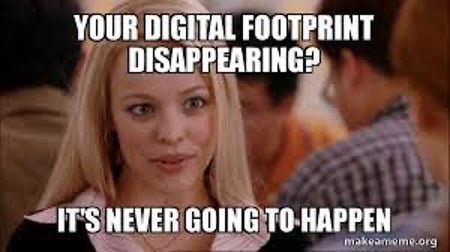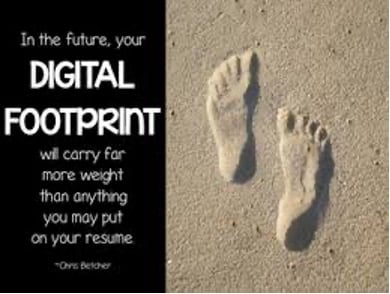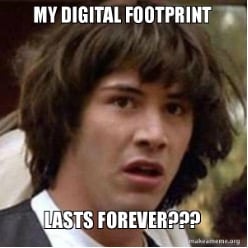
Estimated Reading Time: 4 Minutes
Your digital footprint begins with a single click – and grows each and every time you are online. Sometimes you knowingly contribute to this footprint; other times, organizations contribute to your digital footprint without you even knowing it. Either way, it is important to understand what a digital footprint is, why it matters, and some ways to protect it.

What is a Digital Footprint?
The term “digital footprint” refers to the compilation of data collected every time you are online and visit a website, send an email, fill out online forms, and sign up for online services. It is the trail of “breadcrumbs” you leave online both knowingly and unknowingly every time you are online and shop, download apps, and subscribe to blogs/newsletters/updates.
What is an Active Digital Footprint?
An “active digital footprint” refers to personal information you share knowingly about yourself – most commonly through posting on social media and networking sites. It also refers to information you share when you sign up for newsletters, promotions, and online accounts.
What is a Passive Digital Footprint?
A “passive digital footprint,” on the other hand, is created without you necessarily knowing about it. For example, websites collect information about where you are connecting from (through your IP address), what you click on, and how often you visit the site. These bits of information, called “cookies,” are what allow organizations to target advertising and content that you will most likely find relevant.

Why Does Your Digital Footprint Matter?
The combination of information provided online – both voluntary and involuntary – contributes to your online reputation that can be accessed by anyone, anytime, anywhere. Employers, recruiters, university admissions personnel, business partners, fellow volunteers... the list of who can see your digital footprint is virtually endless. With a simple search, people can learn a lot about you and your information can be taken out of context and misinterpreted. The information gathered can be altered and used against you in any number of ways. Your online reputation may be damaging your “real” reputation without you even knowing it.
Worse yet, your identity could be compromised and acquired by cyber criminals. According to Javelin Strategy & Research's 2022 Identity Fraud Study, there were 5.2 million account takeover victims in 2021 with total losses of $11.4 billion – a 90% increase since 2020.” Your digital footprint is an easy first step to hit the ground running with your identity.

How Can You Protect Your Digital Footprint?
The odds of identity theft are far greater than you can imagine and it can affect anyone and everyone, across all generations. Although you can never fully delete your digital footprint, here are some tips to minimize it:
Be mindful of the information you share online.
First and foremost, you should be cautious with what you share on social networks. Avoid logging into sites and apps through Facebook, as this is one of the top ways to multiply both your active and passive footprints. You should also refrain from entering personal data on public Wi-Fi where your footprint can travel far quicker into the wrong hands.
Use good cyber hygiene every time you are online.
Follow simple tips such as reviewing your privacy settings regularly, using strong passwords and multi-factor authentication, and keeping software up-to-date to limit both active and passive growth of your digital footprint. And avoid using unsecure websites (those that don’t begin with HTTPS, where the S stands for secure) – these are known traps for your footprint!
Clean up your digital footprint.
Regularly audit your online reputation by performing a search of yourself online and reviewing your risk of identity theft. Delete old accounts you are no longer using, unsubscribe to services and newsletters you no longer need, and periodically review your financial and medical records. Use the same principles of exploring in nature – leave no trails and take out what you take in.
Run — don’t walk — to get help.
If your digital footprint does become an issue and you suspect your identity has been compromised, report it immediately to the Federal Trade Commission at IdentityTheft.gov, and if applicable, the site where you suspect it occurred. You can also sign up for comprehensive identity protection services that include credit and identity monitoring.
Complimentary IDRiskIQ™ Assessment
Since we’re on the subject of digital footprints, now is a great time to review your own risk for identity theft and fraud by taking your complimentary IDRiskIQ™ assessment. IDRiskIQ evaluates individuals’ demographics, online behavioral attributes, and the devices they use to better assess their susceptibility to fraud. Once the assessment has been completed, you will receive your score along with immediate, personalized feedback on steps you can take to protect yourself against cybercrime and identity fraud.
Having a digital footprint is a fact of life; considering the types of data we share and with whom we share it is one of the first steps to achieving peace of mind in today’s digital era.


.png?width=102&height=102&name=Iris-Generali-Logo-White%20(1).png)




